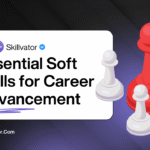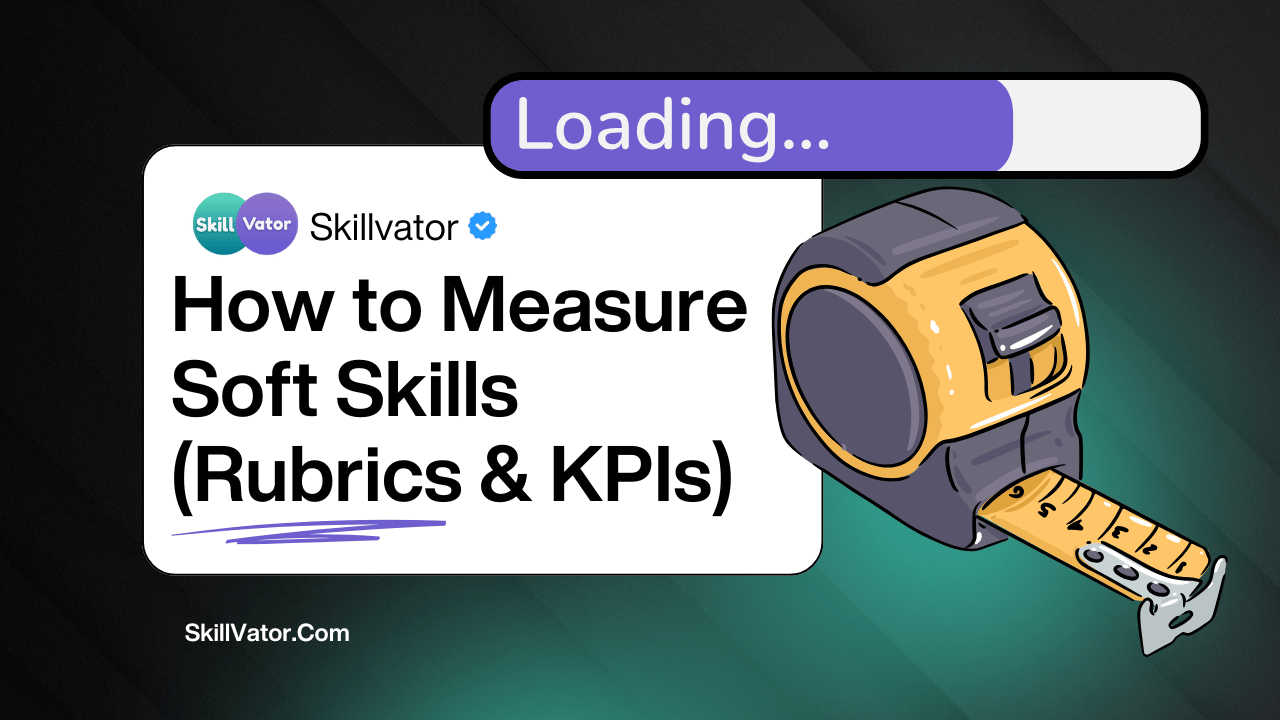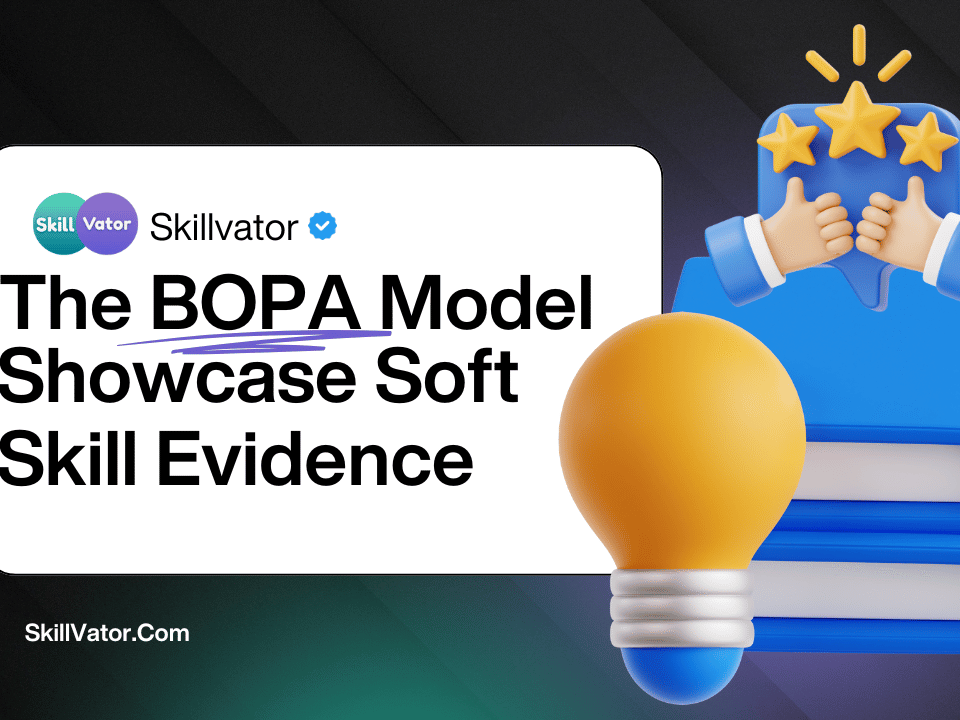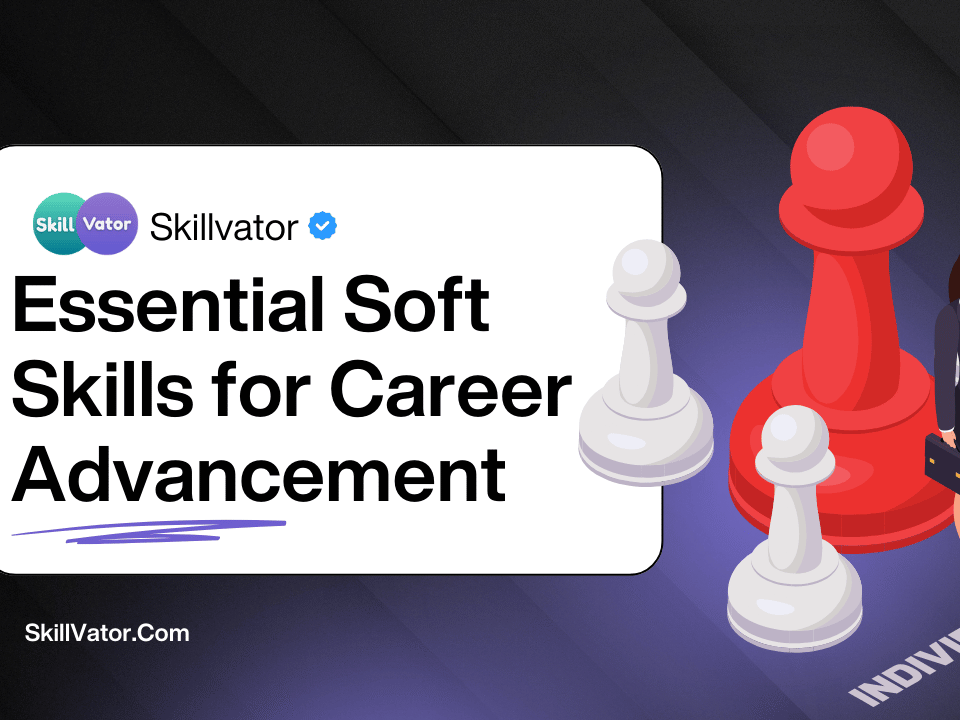Learn how to measure soft skills with clear rubrics, KPIs, and examples. Track communication, teamwork, adaptability, leadership, and problem-solving—fairly. so stay with Skillvator in this article
Why measure soft skills at all? and How to Measure Soft Skills ?
Technical skills get you into the role; soft skills (communication, teamwork, adaptability, leadership, problem-solving) move you forward. Yet most teams still treat them as “intangibles.” That’s risky. Without a shared definition and a consistent way to observe, score, and coach, feedback becomes subjective and promotions feel political.
This guide gives you a practical, friendly, bias-aware system to measure soft skills with:
-
Behavioral rubrics (1–5 scale) you can calibrate as a team
-
KPIs tied to real work (not personality tests)
-
Data sources that don’t invade privacy
-
A ready-to-use Scorecard and 90-day rollout plan
Use it whether you’re an individual contributor, a manager, or an L&D/HR leader.
Discover the key soft skills that drive career growth — from communication and teamwork to adaptability, leadership, and problem-solving. Learn how mastering these workplace skills can accelerate your career path.
👉 Read the full guide on Soft Skills for Career Advancement
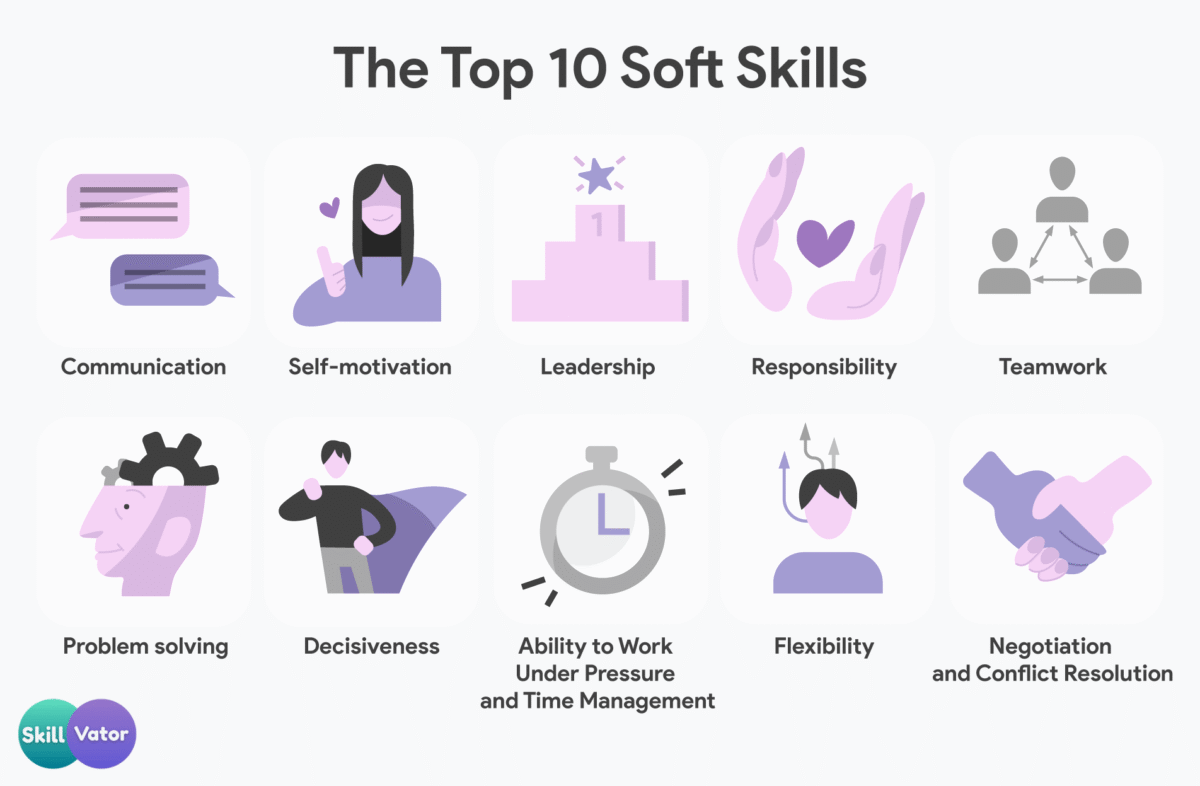
What “measurement” should and shouldn’t be
-
Measure behaviors and outcomes, not personality labels.
We care about what people do and deliver with others, not who they “are.” -
Blend qualitative and quantitative signals.
Numbers without context can mislead; narratives without structure can drift. Use both. -
Design for coaching and growth.
Scores are conversation starters—always paired with examples and next steps.
The BOPA Model: A simple frame for soft-skill evidence
Sample Interview Answer (Adaptability):
-
Behavior: “When our team had to switch project management tools mid-project, I quickly learned the new system and created a short training guide for my team.”
-
Outcome: “This helped us transition smoothly without missing deadlines.”
-
Proof: “My manager highlighted my contribution in the quarterly review.”
-
Application: “I now use the same approach when onboarding new technology in my current role.”
You can reed this article about : The BOPA Model
Core Rubrics (1–5) + KPIs for the Big Five Soft Skills
Use 1 = novice, 3 = proficient, 5 = exemplary. Calibrate with examples from your context.
1.Communication
Behavioral Rubric
-
1 – Novice: Messages are long or vague; next steps unclear; audience fit off.
-
3 – Proficient: Clear structure; tailors detail to audience; closes with owners & dates.
-
5 – Exemplary: Persuasive storytelling; anticipates objections; influences decisions.
KPIs & Signals
-
Meeting recap rate: % of meetings with a written 3–5 line recap (owner, deadline, decisions).
-
Stakeholder clarity score: 1–5 pulse after key updates (“I know what’s happening and why”).
-
Rework due to miscommunication: # of avoidable clarifications / project.
-
Executive summary adoption: % of updates that begin with the ask/decision first.
Artifacts (Outputs)
-
One-pager briefs, decision memos, release notes, client updates.
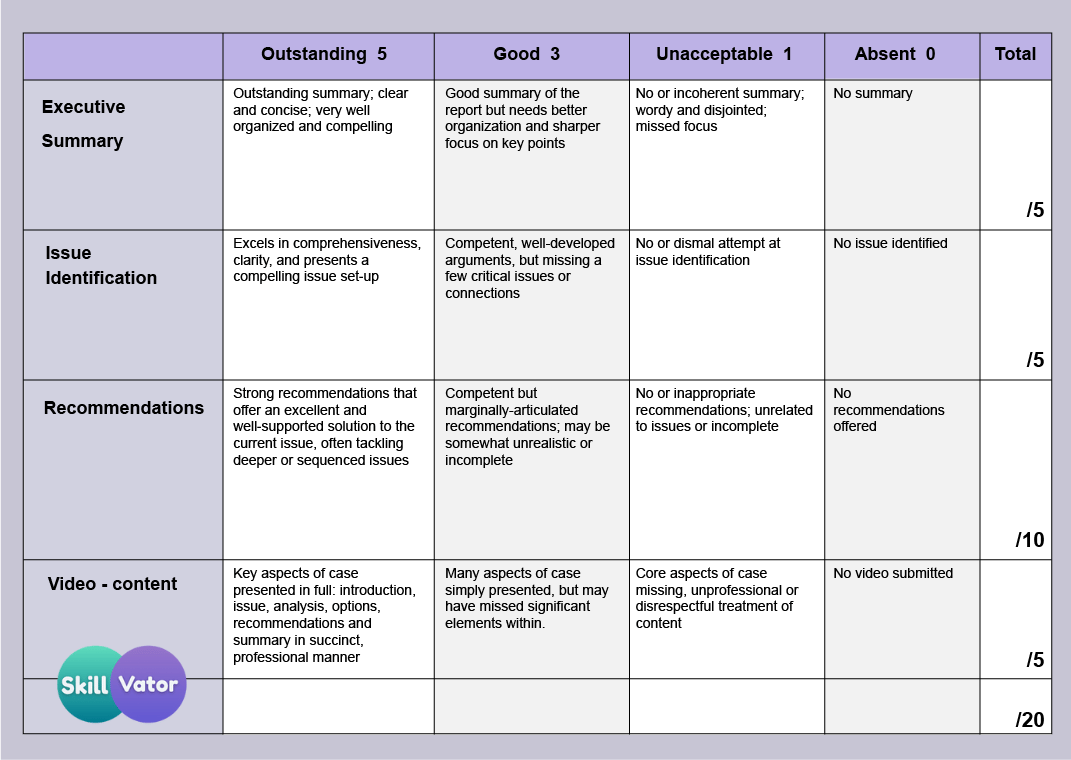
2.Teamwork & Collaboration
Behavioral Rubric
-
1 – Novice: Works in silos; surfaces issues late; defensive in conflict.
-
3 – Proficient: Aligns goals, clarifies roles (RACI), raises risks early, credits others.
-
5 – Exemplary: Orchestrates cross-functional wins; enables psychological safety; resolves conflict constructively.
KPIs & Signals
-
On-time cross-functional milestones: % delivered as planned.
-
Dependency lead time: Avg. days between flagging a dependency and resolution.
-
Handoff error rate: Errors traced to unclear responsibilities / 100 handoffs.
-
Peer collaboration score: 360 item like “Collaborates effectively across teams” (1–5).
Artifacts
-
Project briefs, RACI, risk logs, shared roadmaps.
3.Adaptability
Behavioral Rubric
-
1 – Novice: Resists change; struggles to reprioritize; blames external factors.
-
3 – Proficient: Reprioritizes with rationale; communicates plan changes; learns new tools fast.
-
5 – Exemplary: Anticipates change; runs experiments; designs resilient processes.
KPIs & Signals
-
Time-to-adopt new process/tool: Days to competence from rollout.
-
Change log quality: Captures trigger, response, and lesson learned for pivots.
-
Experiment cadence: # of small tests per quarter; % with documented learning.
-
Resilience rating: 1–5 peer/manager pulse: “Stays effective under shifting priorities.”
Artifacts
-
Change logs, post-mortems, SOP updates.
4.Leadership (with or without a title)
Behavioral Rubric
-
1 – Novice: Waits for direction; avoids ownership; minimal coaching.
-
3 – Proficient: Sets clear goals; removes blockers; gives/receives feedback; mentors peers.
-
5 – Exemplary: Multiplies others’ effectiveness; shapes strategy; builds strong culture.
KPIs & Signals
-
Coaching outcomes: Mentee goal completion; internal mobility/promotions; skill uplift.
-
Blocker removal speed: Median time to resolve issues escalated to you.
-
Team health pulse: 1–5 on clarity, trust, and psychological safety.
-
Delegation effectiveness: % tasks delivered on spec & on time when delegated.
Artifacts
-
Team charters, goal docs, coaching plans, feedback notes (SBI format).
5.Problem-Solving
Behavioral Rubric
-
1 – Novice: Jumps to solutions; unclear success metrics; poor follow-through.
-
3 – Proficient: Frames problem, explores options, pilots, measures, iterates.
-
5 – Exemplary: Addresses root causes; scales repeatable solutions; documents learning.
KPIs & Signals
-
Time-to-resolution: From problem identification to stable fix.
-
Defect recurrence: % of issues resurfacing within 90 days.
-
Decision doc adoption: # of decisions made with a written options/trade-offs doc.
-
Outcome ROI: Impact vs. cost/effort (qualitative narrative + basic math).
Artifacts
-
Problem statements, pre-mortems, decision docs, A/B test logs.
Sample 360 Items (1–5 Likert)
-
Communication: “Keeps updates concise and decision-ready.”
-
Teamwork: “Surfaces risks early and collaborates on solutions.”
-
Adaptability: “Responds to change with a clear, revised plan.”
-
Leadership: “Develops others and clears blockers quickly.”
-
Problem-Solving: “Frames problems with data and tests practical options.”
Tip: Limit to 10–12 items to reduce rater fatigue. Always include free-text examples.
The Soft Skills Scorecard (0–100)
Create a single view that blends rubric scores, KPIs, and artifacts. Example weights:
-
Communication: 20
-
Teamwork: 20
-
Adaptability: 20
-
Leadership: 20
-
Problem-Solving: 20
Total: 100
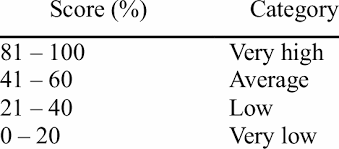
How to compute:
-
For each skill, average: (Rubric score/5 × 50) + (KPI index × 50)
-
KPI index = normalized average of your KPIs for that skill (0–1).
-
-
Multiply by the skill weight (as a percentage of 100).
-
Sum all five skills for the final score.
Example (Communication):
-
Rubric = 4/5 ⇒ 0.8 × 50 = 40
-
KPI index (recap rate 0.9, clarity 0.8, rework inverse 0.7 → avg 0.8) ⇒ 0.8 × 50 = 40
-
Skill score = 80/100 × weight 20 = 16 points toward the total 100.
Keep a narrative section next to the score with 2–3 concrete examples and one development focus. Numbers do not replace coaching.
Data Sources (Low friction, privacy-aware)
-
Observations: Manager notes tied to real moments (1–2 lines, SBI format).
-
Artifacts: Docs, briefs, recaps, SOPs, decision memos (linked, not copied).
-
360 pulses: Short, quarterly; choose 5–8 raters max; rotate to reduce bias.
-
Operational metrics: On-time delivery, cycle time, handoff errors, defect recurrence.
-
Self-reflections: Monthly “wins, misses, lessons, experiments” (½ page).
Ethics & privacy
-
Don’t scrape personal DMs or record meetings covertly.
-
Share the rubric before measuring.
-
Store only what you need, for as long as you need, with access controls.
Calibration & Fairness (reduce bias)
-
Calibration circles: Managers meet monthly to review sample evidence and align what “3” vs “4” looks like.
-
Rater mix: Blend peers, cross-functional partners, and manager to avoid single-source bias.
-
Context tagging: Note constraints (new team, inherited tech debt, sudden scope change).
-
Evidence rule: Each rating needs two pieces of evidence (e.g., an artifact + a peer comment).
90-Day Rollout Plan (team or company)
Weeks 1–2: Define & Baseline
-
Publish the rubric (this guide is a starter).
-
Run a self-assessment + manager assessment (no 360 yet).
-
Pick 2 KPIs per skill to start; keep it simple.
Weeks 3–6: Collect Light Evidence
-
Start meeting recaps and project briefs (communication & teamwork).
-
Introduce change logs (adaptability) and decision docs (problem-solving).
-
Managers give SBI feedback weekly; capture 1–2 examples per person.
Weeks 7–10: First 360 Pulse + Coaching
-
5–8 raters per person; 10–12 items; include free-text.
-
Coaching sessions: 30 minutes each—one strength to double down on, one skill to improve, one habit to practice.
Weeks 11–13: Review & Adjust
-
Calibration circle aligns tough scores; update examples.
-
Pick next quarter’s experiment (e.g., better delegation checklists).
-
Celebrate wins; publish anonymized learnings.
IC vs. Manager: which KPIs fit?
| Skill | IC-leaning KPIs | Manager-leaning KPIs |
|---|---|---|
| Communication | Recap rate; executive summary quality | Stakeholder clarity (execs); decision-readiness of updates |
| Teamwork | Handoff errors; dependency lead time | Cross-team milestone hit rate; conflict resolution speed |
| Adaptability | Time-to-adopt new tool; change log entries | Portfolio reprioritization clarity; experiment cadence across teams |
| Leadership | Peer mentoring sessions; initiative ownership | Mentee outcomes; team health pulse; blocker removal speed |
| Problem-Solving | Time-to-resolution; decision docs produced | Defect recurrence org-wide; ROI of scaled solutions |
Example: Turning behaviors into metrics (Communication)
-
Behavior: “Starts updates with the decision or ask.”
-
Artifact: Update doc showing the ask in line 1.
-
Perception: Stakeholder clarity pulse = 4.6/5 this quarter.
-
Achievement: Execs approved roadmap in 1 meeting (vs. 3 last quarter).
-
KPI: Decision-first update rate = 85% (measured via a simple checklist after key updates).
Templates (use or adapt)
Meeting Recap (≤5 lines)
-
Decision/Outcome:
-
Owners:
-
Deadlines:
-
Risks/Dependencies:
-
Next Check-in:
Change Log Entry (Adaptability)
-
Trigger → Response → Result → Lesson → Next action/date
Decision Doc (Problem-Solving)
-
Problem & success metric
-
Options (pros/cons, risks)
-
Decision & rationale
-
Owner, cost/effort, review date
Coaching Note (Leadership)
-
Goal for mentee → Practice plan → Check-in date → Outcome
Common pitfalls (and quick fixes)
-
Pitfall: Over-quantifying the unquantifiable.
Fix: Keep 2–3 KPIs per skill max; balance with examples. -
Pitfall: Surprise evaluations.
Fix: Publish the rubric; practice it for a cycle before using it in performance reviews. -
Pitfall: One rater dominates.
Fix: Use a rater mix; weight manager 40%, peers 40%, cross-functional 20% (adjust to culture). -
Pitfall: Measuring outputs, not outcomes.
Fix: Pair artifacts with a result (e.g., recaps + fewer handoff errors). -
Pitfall: Tool obsession.
Fix: Start in docs/spreadsheets. If it works, then automate.
How to talk about measured soft skills on your resume & LinkedIn
-
Resume bullets (pair behavior + metric + outcome):
-
“Introduced decision memos; reduced approval cycles from 3 to 1 meeting.”
-
“Standardized handoffs with RACI; cross-team errors down 32%.”
-
“Coached 3 juniors; two promoted within 12 months.”
-
-
LinkedIn About: Include 3 quantified stories mapped to communication, teamwork, adaptability, leadership, problem-solving.
-
Featured: Link a sanitized decision doc or project brief to show, not tell.
FAQs (People Also Ask)
Q1: What’s the best way to measure soft skills fairly?
Use a published rubric, collect two forms of evidence (artifact + perception or outcome), and run calibration circles to align ratings.
Q2: Can we put a single number on soft skills?
You can (scorecards help compare across teams), but always include context and examples. The number supports—not replaces—judgment.
Q3: How often should we measure?
Quarterly is a good cadence: light pulses monthly (artifacts + quick KPIs), fuller review each quarter, calibration monthly for managers.
Q4: Are personality tests useful?
They can spark self-reflection, but they don’t measure performance behaviors. Favor work evidence over traits.
Q5: How do I avoid bias in 360s?
Limit items, rotate raters, train on the rubric with real examples, and require specific evidence for high/low scores.
Final take
Measuring soft skills isn’t about turning humans into spreadsheets. It’s about making great teamwork visible, coachable, and repeatable. If you anchor on behaviors, gather just enough evidence, and keep the process transparent, you’ll build a culture where communication is crisp, collaboration is safe and fast, change is navigable, leadership is practiced at every level, and problems actually get solved. thanks for reading this content on SkillVator

